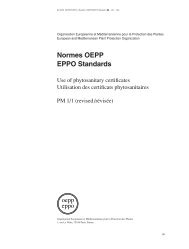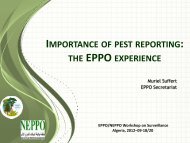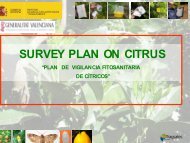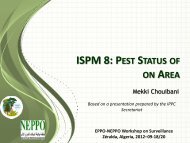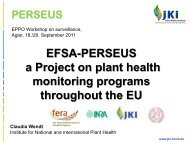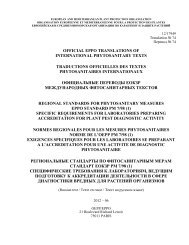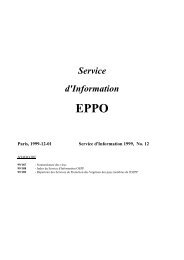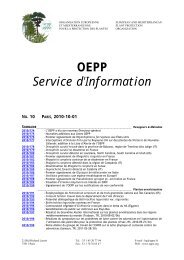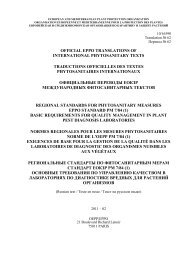Differentiation of Begomoviruses and Bemisia tabaci biotypes using ...
Differentiation of Begomoviruses and Bemisia tabaci biotypes using ...
Differentiation of Begomoviruses and Bemisia tabaci biotypes using ...
You also want an ePaper? Increase the reach of your titles
YUMPU automatically turns print PDFs into web optimized ePapers that Google loves.
<strong>Differentiation</strong> <strong>of</strong> <strong>Begomoviruses</strong> infecting<br />
tomato crops <strong>and</strong> <strong>Bemisia</strong> <strong>tabaci</strong> <strong>biotypes</strong><br />
<strong>using</strong> real time PCR<br />
Lambros C. Papayiannis 1 <strong>and</strong> Nicolaos I. Katis 2<br />
1 Agricultural Research Institute, Nicosia, Cyprus<br />
2 Aristotle University <strong>of</strong> Thessaloniki, Greece
Tomato yellow leaf curl disease (TYLCD)<br />
TYLCD is one <strong>of</strong> the most devastating viral diseases <strong>of</strong> tomato,<br />
ca<strong>using</strong> severe damage <strong>and</strong> heavy losses in many tropical <strong>and</strong><br />
subtropical regions <strong>of</strong> the world<br />
EPPO 2005
Young plants<br />
Symptomatology on tomato plants<br />
Severe stunting<br />
Bushy appearance<br />
Small, puckered <strong>and</strong> distorted leaves<br />
Downwards leaf curling<br />
Interveinal chlorosis<br />
Usually produce unmarketable fruits
Older plants<br />
Symptomatology on tomato plants<br />
Abnormal growth above<br />
point <strong>of</strong> infection<br />
Some flowers may fall<br />
or fail to set fruits
Cultivated plants<br />
TYLCD Host Range<br />
Phaseolous vulgaris Capsicum annuum<br />
>100 Weed plants
Several virus species have been shown to be the causal agents <strong>of</strong> the<br />
disease worldwide, all assigned in the genus Begomovirus <strong>of</strong> the family<br />
Geminiviridae<br />
EPPO region: two main species <strong>and</strong> two recombinants<br />
Tomato yellow leaf curl virus<br />
(TYLCV)- also known as Israel type<br />
Causal agents <strong>of</strong> TYLCD<br />
Tomato yellow leaf curl Sardinia<br />
virus (TYLCSV)- Sardinia type<br />
Tomato yellow leaf curl Malaga virus (TYLCMaV)<br />
Tomato yellow leaf curl Axarquia virus (TYLCAxV)
<strong>Bemisia</strong> <strong>tabaci</strong> Genadius<br />
The whitefly vector <strong>Bemisia</strong> <strong>tabaci</strong> transmits Begomovirus species in<br />
a persistent, circulative manner<br />
First reported in 1889 by Gennadios infesting tobacco (Aleurodes<br />
<strong>tabaci</strong>)<br />
1980 – today Has spread around the globe, infesting vegetable,<br />
ornamental, fiber crops <strong>and</strong> many other arable <strong>and</strong> weed plants
1160 different species <strong>of</strong> whiteflies have been identified so far<br />
<strong>and</strong> B. <strong>tabaci</strong> is considered to be among the most important ones<br />
Polyphagous – colonizes > 600 Eudicots<br />
High reproductive capacity (11-15 generations per year)<br />
Adapts <strong>and</strong> spreads very easy<br />
High genetic polymorphism - Biotypes<br />
Insectiside resistance<br />
Direct damages – feeding<br />
activity<br />
Indirect damages –Transmission >100 plant viruses
Detection methods <strong>of</strong> <strong>Begomoviruses</strong> involved in TYLCD<br />
• Serology<br />
• Molecular Hybridization<br />
• Loop Mediated Isothermal Amplification<br />
• Polymerase chain reaction (specific primers, RFLP, SSCP)<br />
• qPCR assay for quantitation <strong>of</strong> TYLCSV<br />
Detection methods currently used for identification <strong>of</strong><br />
<strong>Bemisia</strong> <strong>tabaci</strong> <strong>biotypes</strong><br />
• Polymerase chain reaction – RFLP, RAPD<br />
• Sequencing analysis <strong>of</strong> mtCOI gene<br />
• Microsatellite analysis
AIM OF THIS STUDY<br />
Development <strong>and</strong> validation <strong>of</strong> primers <strong>and</strong> probes for the<br />
detection <strong>and</strong> differentiation <strong>of</strong> viruses <strong>and</strong> vectors involved in<br />
Tomato yellow leaf curl disease epidemics <strong>using</strong> Real-Time<br />
TaqMan PCR technology<br />
Identify the incidence <strong>and</strong> prevalence <strong>of</strong> <strong>Begomoviruses</strong> <strong>and</strong><br />
<strong>Bemisia</strong> <strong>tabaci</strong> <strong>biotypes</strong> in Greece <strong>and</strong> Cyprus
PRIMER TYLCV F<br />
Materials <strong>and</strong> Methods<br />
Probe TYLCV TAQ<br />
PRIMER TYLCV R<br />
PRIMER TYLCSV F PRIMER TYLCSV R<br />
Probe TYLCSV TAQ
Begomovirus Isolates<br />
DNA extraction<br />
Materials <strong>and</strong> Methods<br />
Polymerase chain reaction (PCR): TY(+)/TY(-) primers followed by RFLP<br />
analysis – AvaII (Accotto et al. 2001) – EPPO Protocol<br />
Multiplex PCR primers AC1048/AV632/AC950 (Martinez-Culebras et al. 2001)<br />
Results were compared to the Real Time PCR assay
DNA was extracted from females<br />
Materials <strong>and</strong> Methods<br />
B. <strong>tabaci</strong> samples were collected from Greece, Cyprus,<br />
Israel, Spain, Italy, Mexico, USA<br />
Charge Switch® magnetic bead technology<br />
Partial amplification <strong>and</strong> sequencing analysis <strong>of</strong> mitochondrial<br />
cytochrome oxidase I gene (Frohlich et al., 1999)<br />
Partial amplification <strong>and</strong> RFLP analysis <strong>of</strong> mitochondrial cytochrome<br />
oxidase I gene (Bosco et al., 2003)
Primers <strong>and</strong> Probes were designed for<br />
Real Time TaqMan PCR tests<br />
BIOTYPE Q<br />
BTQ-F: AATGCCTCGCCGATATTCAG<br />
BTQ-R: AATCCTTCCCGCAGAAGAAATT<br />
BTQ-T: TexasRed-TTATGCTGATTGTTATCTAGTATGGAACA-BHQ<br />
BIOTYPE B<br />
BTB-F: GGTATTTGGAAGGTTGGGTATAATTTAT<br />
BTB-R: ACTGTGAATATATGATGACCTCAAACAA<br />
BTB-T: FAM-CTATATTGACTATTGGTATTCTAGGGTTT-BHQ<br />
Materials <strong>and</strong> Methods
360 ζβ<br />
150 ζβ<br />
68 ζβ<br />
RFLP (Ava II)<br />
TYLCV<br />
302 ζβ<br />
277 ζβ<br />
TYLCSV<br />
1 2 3 4 5 6 7<br />
Results<br />
Identification <strong>of</strong> TYLCV <strong>and</strong> TYLCSV <strong>using</strong> reported protocols<br />
Multiplex PCR<br />
TYLCV/TYLCSV<br />
TYLCSV-Sardinia TYLCV-Isr<br />
TYLCV-Sar<br />
Λακωνία<br />
1 2 3 4 5 6 7 8 9 10 11 12<br />
TYLCV-Isr<br />
Κύπρος
Multiplex detection <strong>of</strong> TYLCV/TYLCSV<br />
with Real-Time TaqMan PCR<br />
TYLCV<br />
TYLCSV
PCR-RFLP results from B. <strong>tabaci</strong><br />
samples<br />
<strong>Bemisia</strong> <strong>tabaci</strong><br />
Biotype Β<br />
<strong>Bemisia</strong> <strong>tabaci</strong><br />
Biotype Q
Multiplex detection <strong>of</strong> B <strong>and</strong> Q <strong>biotypes</strong><br />
B. <strong>tabaci</strong> with Real-Time TaqMan PCR<br />
B <strong>biotypes</strong><br />
Q-like <strong>biotypes</strong><br />
Cyprus<br />
Greece<br />
Israel<br />
Spain<br />
USA<br />
Α-Biotype<br />
T.vaporariorum<br />
Papayiannis et al., 2009 Bulletin <strong>of</strong> Entomological Research
Summary<br />
A real time PCR assay was developed for multiplex detection<br />
<strong>and</strong> differentiation <strong>of</strong> <strong>Begomoviruses</strong> involved in TYLCD<br />
The assay is extremely sensitive (>100 times from<br />
conventional PCR), specific <strong>and</strong> suitable for typing large numbers<br />
<strong>of</strong> field crops <strong>and</strong> weeds<br />
A TaqMan PCR assay for rapid discrimination <strong>of</strong> <strong>Bemisia</strong> <strong>tabaci</strong><br />
<strong>biotypes</strong> B <strong>and</strong> Q was also developed <strong>and</strong> evaluated for several<br />
whitefly individuals from different geographical regions<br />
Both assays were successfully used in a large scale survey for<br />
identification <strong>of</strong> the virus species <strong>and</strong> vectors involved in TYLCD<br />
in Greece <strong>and</strong> Cyprus
Summary<br />
In Greece both TYLCV <strong>and</strong> TYLCSV coexist<br />
In Cyprus TYLCV is the only Begomovirus related to TYLCD<br />
In Cyprus B. <strong>tabaci</strong> biotype B <strong>and</strong> possibly Q are involved to<br />
TYLCD<br />
In Greece biotype Q is the predominant type. B biotype is<br />
reported for the first time in Rhodes isl<strong>and</strong><br />
Other B. <strong>tabaci</strong> -transmitted viruses are found in countries<br />
neighboring EU <strong>and</strong> new strategies for managing the whiteflyvirus<br />
complex should be developed <strong>and</strong> adopted
Acknowledgements<br />
Pr<strong>of</strong>. J.K.Brown, J.K.Brown,<br />
University <strong>of</strong> Arizona<br />
All those who have supplied Begomovirus-infected<br />
Begomovirus infected<br />
material <strong>and</strong> whitefly samples for our studies<br />
Dr L. Tomassoli (Istituto Istituto Sperimentale per la Patologia Vegetale, Rome, Italy), Italy),<br />
Dr. J. Morris (Central Science laboratory, York, UK), Pr<strong>of</strong>. Gutierrez <strong>and</strong> A.<br />
Alvaro-Fern<strong>and</strong>ez<br />
Alvaro Fern<strong>and</strong>ez (Instituto Instituto Agr<strong>of</strong>estal DelMediterraneao, Valencia, Spain),<br />
Pr<strong>of</strong>. A. M. Idris (University <strong>of</strong> Arizona), Dr G. Anfoka (Faculty <strong>of</strong> Agricultural<br />
Technology, Al-Balqa Al Balqa’ Applied University, Jordan), Mr. A. Paraskevopoulos<br />
(Directorate Directorate <strong>of</strong> Agriculture, Kyparissia, Kyparissia,<br />
Greece), Dr. Horowitz, Horowitz,<br />
Israel<br />
Cyprus Research Promotion Foundation for funding<br />
this study
Thank you!




